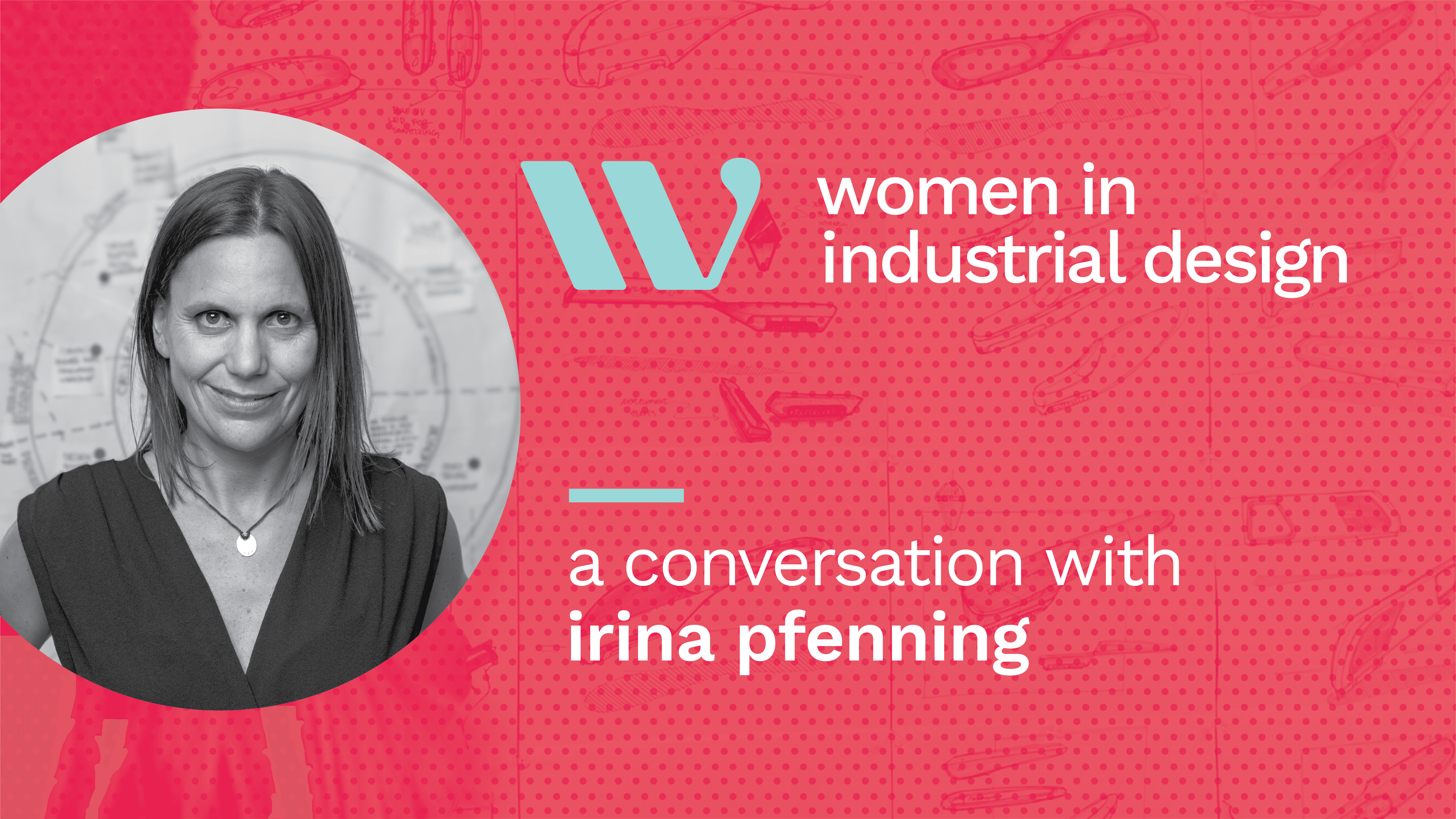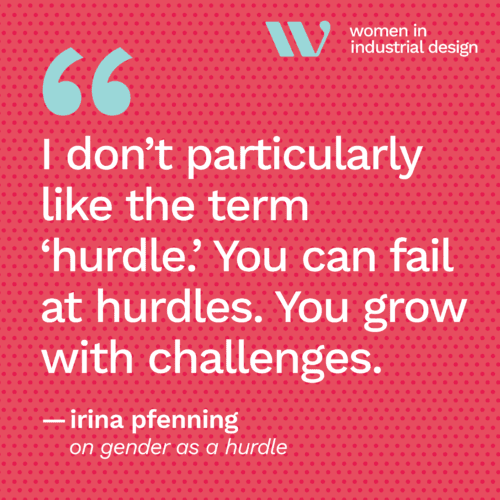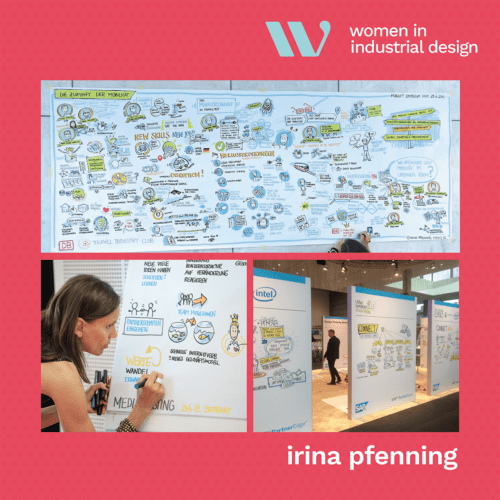Women in Industrial Design: A Conversation with Irina Pfenning

If you are reading this interview series for the first time, welcome. For the past several months we have been talking with female industrial designers about their experiences as women in a culture where they have long been under-represented.
What have they seen? How have they adjusted? How might the design profession better serve women who choose it as a career path? What advice do they have for women just starting their careers? How might we make them feel more welcome as they grow in the profession? At the end of this project, we plan to roll up all the talks and our takeaways in a form we can share.
Along the way, we have been using this journey to ensure that the hiring, mentoring, and work processes at Sprout are as welcoming and expansive as possible. We have recently added a few new female designers to the team, and our work from home and personal time off policies are evolving to reflect the insights we have gained throughout this process. Candid, open conversations about what’s working and what isn’t remain an important part of Sprout culture, where all voices have a seat at the table.
In our latest interview, we talked with Irina Pfenning, a European-born industrial and UX designer who was educated in the US and has spent time working in both the US and EU. Now based in Heidelberg, Germany, Irina founded INOVIS and co-founded Innovate-now. She helps enterprises to strategically unleash the power of UX and Design Thinking in their organizations. She creates and facilitates Design Thinking and Innovation Workshops utilizing visualization and visual thinking to amplify and accelerate big picture thinking. Her perspective on the business culture within her culture strikes some different notes from those to date.


On gender as a hurdle—
It doesn’t start when you enter the workplace. It is the observations and the experiences before that point that shape us. The people who accompany us through our school years and studies, who are role models and friends. I have never felt my gender was a barrier that prevented me from doing the things that were important to me and interested me. Yes, it can be a challenge to be the only woman in the room (which is often the case in the industrial design environment) but I have always embraced that challenge. My background is in endurance sports and cycling, so I appreciate challenges.
And isn’t the essence of design to find creative, good new solutions to challenges? I don’t particularly like the term ‘hurdle.’ You can fail at hurdles. You grow with challenges.
Ideas for promoting change in gender culture at the studio level—
Fortunately, my experience with today’s design environment has been very open and equal. Design studios are often very progressive and are trying out new organizational forms such as holacracy, which have a strong influence on work culture. This methodology moves the focus more to skills, soft skills and competencies of each individual and gender does not play a crucial role.
To solve the problem of gender inequality, there must be a re-thinking and overcoming of deeper biases. Equal respect and equal pay are just the basics. In my perception, it is not a question of male vs female but rather of agile/designer mindset vs traditional hierarchic company thinking. This becomes very visible and tangible in an innovation workshop setting, which can easily feel like a clash of cultures. But it is precisely here that we as designers enjoy ‘fool’s freedom’ (Narrenfreiheit, as we say in German). It’s our chance — and our job — to create visibility, to advocate for new ways of thinking, to create an open design space, to leave titles at the door, to question the dress code, and to offer a different approach that is about new perspective and ideas— not just roles.
Invite your team to be honest and openly discuss the culture within your studio. See where the pain points are and come up with ideas to fix things. But again, it is not just about setting rules for your workplace. The cultural shift has to come from within.
On her pivot to facilitating workshops and coaching other (female) designers—
After my son turned five, I went back to graduate school (for a Master’s in Strategic Design) to refocus and start over. At that point, user experience, strategic design, and design thinking were visibly gaining traction. Since industrial design is the ‘mother ship’ of design thinking, it was mainly about applying the methods and tools to any (business) context. All design skills like visualization, research, connecting the dots, and making ideas visible are deeply rooted in the DNA of industrial design. Design thinking brings in additional skills like understanding business logic, anticipating and using team dynamics in a workshop setting, and dealing with facilitation challenges.
One part of my work is to enable designers to become design thinking coaches. Much more than gender differences, I perceive character traits like introversion and extroversion here. It takes courage, communication skills, empathy and self-confidence. It’s learning by doing.
I now have a lot of workshop experience and know about the critical factors for successful innovation workshops. One of those success factors is to facilitate in teams of two! This way, it is easier for both to pay attention to the dynamics in the room while keeping the goal and agenda in mind. I have worked with many designers who are often great designers but more on the introvert side. The team composition is crucial. Diversity within teams helps too— it’s not men vs women, it’s about covering a broad spectrum and complementing each other.
Advice to women (or anyone) starting work in the industrial design profession—
I see the design profession as a journey— one that is constantly evolving and opening up new opportunities. You become a designer because you have this idea of changing the world, making it a better place, and being a part of the process to create something new. My advice is not gender specific; we all need to accept and embrace challenges. To maintain a growth mindset. To always keep learning. And to be fearless.
Stay curious. Always be curious about what goes on in the world. Because design is not one discipline, it’s all interconnected. It is a strong problem-solving tool that can make a big impact if you combine it to co-create with other disciplines. It’s the designer’s role to understand what’s really going on. What’s the real need? You gain value through the journey of finding out.
Find a mentor. Have somebody with experience in your field you can talk to or bounce ideas with. You don’t have to make every mistake yourself. It can be very beneficial to draw from the experience of trusted professionals.
Expand your skills. Sometimes you have to identify where your needs are. You say, “Okay, I could focus more on communication or my presentation style.” Develop extra skills. Think about how you communicate your ideas with an understanding of psychology and neuroscience— how it works, how you can best present, and how somebody will react.
Understanding business logic is also helpful. You don’t have to understand every in-depth detail but at a good level. The generalist perspective you can provide as a designer is quite valuable in this context. It only gets wider when you can draw from your experience to connect more dots.
Design your network. Always have a network around your office. Surround yourself with inspiring, positive people. People who you can openly talk and interact with to get new ideas. This mindset is really relevant.
Break routines. Routine kills creativity at a certain point. When it gets too easy, designers get bored. Adopting a beginner’s mindset is an ideal way to learn new things in a job you love. But once you find yourself doing the same stuff, don’t hesitate to move on.
Take risks. Search for new challenges. Try new things, like teaching. There are many options for fields you can explore. That’s the beautiful side of design— it opens a lot of doors. You can just take a peek. Or walk through and see where it takes you.
What I read/study to expand my designer’s mind—
I really enjoy TEDx talks on creativity, design, and innovation. But then I also explore different fields like neuroscience and find it very beneficial to Design Thinking. I like reading books from completely different disciplines. The latest book I read was by former President Obama. The way his team came to ideas and solutions was very human centered and close to our process of Design Thinking. Books about empathy and compassion are all somehow related to design or the way we create. You figure out the underlying pattern and put it in your context. How much of it can you transfer? Connecting the dots— that’s where it gets exciting.

